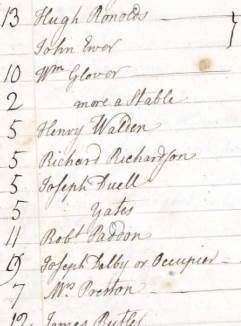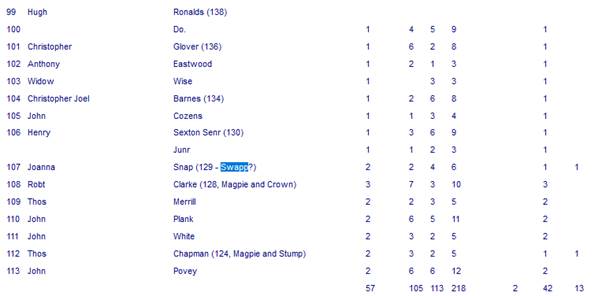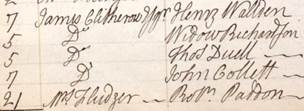
Basics
Home and SearchSite Guide
Brentford Basics
Privacy Policy
Contact
People
FamiliesPhotos of people
Name indexes incl WW1
Memories
Lists, Documents, News
Occupations
Properties
Properties: High StreetProperties: non-High Street
Photos
Maps
1909/10 Valuation Index
Pub Hub
Can You Help?
Seeking...Mystery photos
Roads Off
A-Z listJanet's Research
HistoryBeach's Jam
Nowell Parr
Turner the Artist
Queen Victoria 1840
Brentford Market
80 High Street
Clitherow of Boston House
Four Croxford Brothers
Sources & More
They SaidBooks etc.
Web Links
Next
Site Technology
Author
Home and Search
Not Brentford
Records of Robert Paddon in the Land Tax (Ancestry)
Robert Paddon took on Jno Woods as an apprentice in 1790 and Lorraine Dicksee has a Woods family in New Brentford that may include the same John. This is one of several documents that aim to find out more about Robert Paddon, his work, home and family. This research uses land tax records, coupled with the 1811 census, to find the location of the Paddon family home.
Land Tax records 1767-1798
The earliest land tax record for New Brentford available online is from 1767, the next is from 1780, thereafter records cover the period to 1825 comprehensively.
Robert Paddon is recorded in both 1767 and 1780 land tax records. His home in 1767 was near St Lawrence's Church, with the Parsonage House recorded at the top of the same page, followed by Hugh Ronalds, who occupied property and land adjoining the vicarage on the south side of the High Street.
Excerpts from the 1767 and 1780 records follow.
| 1767 rents & occupier names | 1780 rents, owners & occupiers |
|---|---|
 | Note three matches in tenant names 1767 & 1780 Walden, Richardson, Duell and Paddon
|
A summary of the rentals and names from 1767 and 1780 follow, extended a little from the above. Where surnames match they are noted in full, otherwise just the first two letters . There are additional matches in rentals where names have changed.
| 1767 rent | 10 | 2 | 5 | 5 | 5 | 5 | 11 | 9 | 7 | 12 | 15 | 2 | 2 | 2 | |
| Occupier | Glover | (a) | Walden | Richardson | Duell | Ya | Paddon | Da | Pr | Bu | Ro | Ti | Ma | Bu | |
| 1780 rent | 12 | 2 | 2 | 7 | 5 | 5 | 7 | 21 | 7 | 10 | 12 | 2 | 2 | 2 | 2 |
| Occupier | Glover | (b) | (c) | Walden | Richardson | Duell | Co | Paddon | Ea | Ca | Wi | Dr | Gr | Ea | Bu |
Notes:
(a) 'more a stable' was presumably let to William Glover in 1767 along with his £10 rental
(b) both the £12 rental and following £2 rental ('more stable & warehouse' )were owned by James Clitherow Esquire and presumably both were tenanted by William Glover in 1780
(c) 'more Mr London's barn' was owned by Mrs Fludger in 1780 and may have been built since 1767 as there is no corresponding entry then; as Mrs Fludger was named London before she married the London who used the barn was probably one of her relatives. Read more about Mrs Fludger.
There are sufficient matching names, in the same sequence, to conclude this is the same set of properties in both years. Therefore Robert Paddon was tenant of the same premises in 1767 and 1780; this was the Paddon family home following his marriage in 1766.
Paddon's rent had increased from £11 to £21 in 13 years; this may be a result of his property being extended.
During the same period his wife Mary had four children, two of whom survived to adulthood; his first Charman apprentice moved in with the family in 1770, then Charman's younger brother in 1777.
Later tax records from 1786, 1790 and 1798 show similar matches in tenant names and rentals (allowing for some churn, as is expected: this was a prime site in New Brentford, near St Lawrence's church and across the road from the market).
By 1798 Paddon's three sons had completed their apprenticeships and Paddon's last apprentice, Jno Woods, had finished his seven-year term, although he may have continued to work for Paddon as the latter approached 60.
1811 census
13 years on from 1798, the 1811 census offers a view of occupants of this area of New Brentford.
Robert Paddon died in 1800, but the census may still be helpful in identifying the location of his home and the occupying family. Did they continue to run the drapery business?
'Landmark properties' such as public houses and inns that survived into the 1870s, when the High Street was numbered, can be precisely located and often were recorded in earlier licensing records too. Licensing records give the name of the licensee and their pub/inn, so it is usually possible to identify pubs and inns in the census.
Next, any properties sited between landmark properties can be allocated their approximate High Street number. For example, if there are four properties between landmark properties at 160 and 165 High Street, then there is a good chance they were later numbered 161, 162, 163 & 164. Sometimes it is not so straightforward – the number of properties does not match the number of house numbers; but even then an approximate house number can be deduced.
There is an underlying assumption that both the land tax and census records recorded occupants on a door-to-door basis. This seems to be the case from the land tax records noted above. There are recognisable 'runs' of matching surnames in the land tax that also occur in the census records, and censuses are known to record people property by property. Even if the direction of travel is different in the census to the land tax, the sequence of public houses and inns clarifies location. As well as licensed houses, there are often other landmark properties where long-established families are known to have lived that help to pin down the location of nearby properties.
Having established that, what does it tell us about Paddon's home?
The census shows head of household, the number of families, males, females and total occupants of each property; finally, the number of individuals involved in agriculture, trade or 'other'.
 |
The location of the Paddon home
Comparing the 1798 land tax and 1811 census, there are several matching surnames (bold):
1798: Glover, Avery, now Wise, Woodward, Cozen, Paddon, Swap, Ronalds, Parker, Merrill
1811: Glover, Eastwood, Wise, Barnes, Cozens, Sexton, Snap (assume Swap), Clarke, Merrill
Paddon is no longer recorded in 1811 but his former neighbours Cozens and Swap remain; it is concluded Henry Sexton took over the Paddon home between 1798 and 1811.
As to location, it has already been established the Paddon home was some doors along from the vicarage (139 High Street).
The census enumerator recorded this stretch of the High Street in the same order as the land tax, working his way eastwards along the south side of High Street: after the vicarage (139) the next landmark property is the Magpie and Crown (128) and then the Magpie and Stump (124).
In 1811 Sexton was next but one to the Magpie and Crown. It is concluded the Sexton/Paddon home was at around 130 High Street.
Conclusions
Robert Paddon lived near to and on the western side of the Magpie and Crown (128 High Street), probably at around 130 High Street, between 1767 and 1798. He was a tenant of Mrs Fludger between 1780 and 1798 (and possibly back to 1767): see following notes about Mrs Fludger.
The property he occupied was substantial, with a higher annual rental than nearby properties.
In 1811, following the death of Robert Paddon in 1800, two families, headed by Henry Sexton senior and junior, 12 individuals in total, occupied the property. It can be concluded that this was a substantial property and could comfortably accommodate the Paddon family of six, an apprentice and one or more servants.
Henry Sexton & Sons was recorded in the Pigot 1826 directory as linen drapers in New Brentford; they operated from the property originally tenanted by Paddon (and the property notes for 129/130 High Street show the premises continued to be a drapers into the late 20th century).
Mrs Fludger - Robert Paddon's landlady
William Fludger, 25, of Wallingford Berkshire, married Martha London, 22 of Brentford by licence dated 15 Sep 1746 at Isleworth (Ancestry). The surname appears to be Fludger in the records inspected, but there are references to the family name as Fludyer.
Martha London, daughter of Thomas, was baptised at New Brentford 31 Dec 1724.
Searches for her father,Thomas London, found:
William Simmons, waterman of Old Brentford in the parish of Ealing, left a PCC will prepared and proved in 1740 in which he appointed his cousin Thomas London of New Brentford, currier, as executor. Thomas London also stood to inherit various properties if Swift Samuel Simmons, son of William, had no issue.
Thomas London was a currier, a worker in leather. Martha London married a tanner - another worker in leather:
Martha's husband, William Fludger, left a PCC will on which probate was granted 3 Apr 1770; he was a tanner of Wallingford. In his will he refers to his wife Martha, several children, some under 21, and property in Berkshire and Oxfordshire. It seems Martha and her husband lived in Wallingford following their marriage, although Martha may have inherited property in New Brentford from her father.Martha Fludger also left a PCC will; she was of Wallingford and died in 1806. She mentions no property in Brentford in her will and presumably it had been sold before she died. The 1780 tax record has record of Mr London's barn, owned by Mrs Fludger.
Links
External site: useful summary of Robert Paddon and his family
Notes about Robert Paddon and his sons
Online apprenticeship records used in this research.
Robert Paddon's apprentices who started between 1770 and 1790.
Property notes for 129/130 High Street.
Page published July 2021

